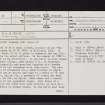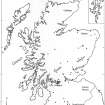Following the launch of trove.scot in February 2025 we are now planning the retiral of some of our webservices. Canmore will be switched off on 24th June 2025. Information about the closure can be found on the HES website: Retiral of HES web services | Historic Environment Scotland
Kilbirnie Loch
Crannog (Period Unassigned), Ewer (Bronze)(Period Unassigned), Tripod Vessel (Bronze)(Period Unassigned), Logboat(S) (Period Unassigned)
Site Name Kilbirnie Loch
Classification Crannog (Period Unassigned), Ewer (Bronze)(Period Unassigned), Tripod Vessel (Bronze)(Period Unassigned), Logboat(S) (Period Unassigned)
Alternative Name(s) Loch Of Kilbirnie; 'the Cairn'; Kilbirnie Loch 1-2
Canmore ID 42219
Site Number NS35SW 5
NGR NS 3238 5356
Datum OSGB36 - NGR
Permalink http://canmore.org.uk/site/42219
- Council North Ayrshire
- Parish Kilbirnie
- Former Region Strathclyde
- Former District Cunninghame
- Former County Ayrshire
NS35SW 5 3238 5356
See also NS35SW 8 and NS35SW 11.
(NS 3238 5356) Crannog (NR) (site of)
OS 6" map (1970)
There used to be a small island, locally called 'The Cairn' (shown on OS 6" map, 1856) in Kilbirnie Loch. It measured about 23 to 25 yards in diameter and was 2ft - 4ft above the water surface. In the summer of 1868 it was shown to be artificial. It was built in four layers - the lowest of logs, some nearly 2 ft in diameter, laid horizontally and mortised together with wooden pins, and in two instances with iron nails. The next layer was of brushwood etc., about 6 inches in depth. The third was of gravel and sand to a depth of 1 1/2 feet to 2 feet, and on top, a pavement of stones not more than 1ft to 2ft in depth. Wood ashes and a hearth were seen in the uppermost layer. Post holes of a rectangular and other huts were noticed, as well as a few fragments of animal bones. On the north east side was evidence of a palisade, and from the northwest margin of the loch, a stone causeway led to the island. This causeway was said to be only 2ft - 3ft in breadth, and was never visible above the water, which was 6ft- 7ft deep on either side. Several canoes, said to number four, were found in 1868 near the south end of this causeway, on the northeast margin of the island. Only one was fairly entire. In this canoe was found a brass ewer (now in the NMAS) and a three-legged pot. The fragment of another canoe was found close to the island, on its northeast side. It was formed of a single oak tree and measured 5ft - 6ft long by 2ft 2ins wide. No description can be given of the other canoes owing to their fragmentary condition.
R W Cochran-Patrick 1873; R Love 1876; L Mann 1933
The site of this crannog is now covered by the steel-works of Colvilles Ltd.
Visited by OS (DS) 30 August 1956.
In 1868 a crannog, a causeway and up to four logboats 'in a less or more entire condition' were revealed at the SW corner of Kilbirnie Loch, which is situated in the industrialised claylands of North Ayrshire at an altitude of about 30m OD. There is no evidence for the direct association of the logboats with the crannog. The dumping of furnace-slag from the adjacent ironworks had caused the lake-bed sediments to be displaced upwards and towards the NE so that the archaeological remains were exposed above the surface of the water. Although some of the published accounts are incorrectly orientated, what are probably the crannog and its causeway are depicted on the 1st edition of the OS 6-inch map (Ayrshire, sheet viii) at NS 3238 5356.
Two of the boats were recorded in some detail, although the incomplete nature of the remains precludes quantitative analysis or the establishment of McGrail morphology codes.
(1). The most complete of these boats was found about 20' (6.1m) N of the crannog. It measured about 18' (5.5m) in length, 3' (0.9m) in breadth and 'close on' 2' (0.6m) in 'depth'; a further length of about 2' (0.6m) had been lost from the bow. The stern was 'square'.
A hole in the bottom of the boat had been repaired, and the 'thin plate or piece of metal' that was found in it may have been a repair-patch. The function of the 'wooden pins' that were also found is unclear.
Also found in the boat (but not necessarily associated with it) there were a bronze ewer and a tripod pot which are held in the collections of the Royal Museum of Scotland. The boat itself disintegrated rapidly on exposure to air.
(2). Part of a second logboat was subsequently found 'close by the island' (and on its NE side) when some of the lake-bed sediment was being dug out for agricultural fertiliser; its fate is not recorded. This boat was worked from 'oak' and measured 5 or 6' (1.5-1.8m) in length by about 2'2" (0.7m) in maximum beam; the floor was between 2?" (65mm) and 3" (76mm) thick and the sides survived to a maximum height of 6" (150mm).
R W Cochrane Patrick 1872; R Love 1876; R J C Mowat 1996.












